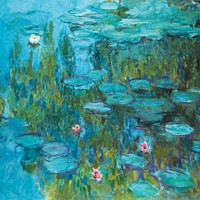|
|
Failing Eyesight and Final Painting
Project
With the success that he had achieved, Monet had been able to enlarge
his property at Giverny, diverting the little stream of the Epte and laying
it out into ponds in a fairy-land garden. This garden, transformed again
and again as he wished, was to be his sole comfort when fate struck him
the cruel blows of the death of his second wife in 1911 and of his son
Jean in 1914. Like Degas, he
had suffered with his eyes, undergone operations and been blind for a
time. Finally in 1922 a double cataract altered his vision. But this did
not prevent him from undertaking a fabulously ambitious task. It was such
an ambitious work, so impervious despite its outward appearance, that
for a long time it was not understood. To some it was a masterpiece, to
others something to be looked down upon, if not scorned.
Ordered for the State by Georges Clemenceau,
the Nympheas consist of some eighty yards of painting in a circular form.
The theme appears to be ponds decked out with water-lilies. In fact these
works are basically a meditation on time span, an attempt at complete
understanding of the world. Repeating an experiment which he had carried
out in about 1910, Monet shortens the visual field of his subject, observes
it from a closer point and thus draws out the flight of perspective. By
this means he turns the whole world upside down and puts the lightest
tones at the feet of the spectator who is usually used to finding them
above his head. The elements of the landscape, branches and foliage, which
also allow him to maintain a sense of height and depth, are intermingled
with their reflections and absorbed by them. Thus it is difficult to know
what is the exact situation. Materiality and weight of his elements are
paired off so as to become lost with and in the reflection of light. Vertical
and horizontal levels, opacity and transparency are no longer opposed
clearly in the mind of the spectator, who suddenly finds himself in a
world where the specific character of things, their weight, relief and
where they are placed, is all mixed up in a fabulous mash. Finally the
circular disposition of the works, sought by Monet himself, and scrupulously
respected in their presentation in the Orangery Museum, increases even
more this effect of a strange new world. As the Baroque architects discovered,
a circular effect does not easily allow the spectator to realise his position
and he tends rather to become lost. Thus confusion is accentuated; the
eye, not finding a convenient place on which to rest, glides over the
border and perceives a sort of passing of time. Instead of the usual frontal
contemplation, it seems to be in the very bosom of nature, embracing a
vast landscape which has no beginning and no end. The height of the frieze
also upsets its position in relation to the phenomena represented. Between
luminous worlds well-managed transitions avoid a sense of rupture. Everything
is linked - dawn, noon, afternoon and twilight - to form a sort of continuity.
Thus the spectator, with his basic perception turned upside down, his
normal landmarks gone and his consciousness of the division of time now
lost, feels himself carried away into a world where categories and orders
of things are stumped off and then disappear. A liberating impression
spreads. The world dematerialises and is changed before our eyes. It becomes
a fluid, a liberation of energy. Only the light spreads across this world
stripped of restraint imposed by the human condition. It demands that
the spectator mingle with it, the only way of accommodating oneself to
its calm, active impulsion. In an instant the fusion of man and the elements
is accomplished and can be experienced. Beyond the light, which has become
the central character, the very mechanism of life is reached.
Certainly Monet was not able to foresee the moral that new generations
were to draw from his work. Kandinsky,
after contemplating a Monet exhibited in Russia in 1895, wrote (Regards
en arriere): "Up till then I was only acquainted with naturalist
art, and to be truthful, with that of Russia.. . and suddenly I found
myself for the first time before a painting which, according to the catalogue,
represented a haystack but which I did not recognise. This bothered and
worried me very much. But I noticed with consternation that not only did
it surprise me, but it imprinted itself indelibly on my memory and reshaped
itself before my eyes in every detail. All this remained confused in my
mind and I could not yet foresee the natural consequences of this discovery.
But what did emerge clearly was the incredible strength, unknown to me,
of a palette which exceeded all my dreams. The painting appeared to me
to be endowed with a fabulous power."
NOTE: For an explanation of how Monet's
Impressionist art led to abstraction, see: Realism
to Impressionism (1830-1900).
We know later what this interrogation of
the subject, this implication of its exacting demands, was to engender.
Some years later another painter, a divisionist in his early days, meditated
on light and colour. Robert
Delaunay studies the theories of Chevreul and from them derives the
term "simultaneous contrast". From 1912 onwards, in his celebrated"
windows" and "circular forms" he demonstrates two ideas
stemming from Impressionist experiments. The first is that light in constant
change "itself engenders shape independent of the presence of objects".
The second is that "autonomous forms of light imply perception of
movement". These two conceptions were to be the basis of his future
development. Pierre Francastel wrote of his "Rythmes sans fin"
of 1934: "It is, so to speak, an adventure of light rays through
the atmosphere. Resurrecting this idea which was the basis of his great
discoveries of 1912 ... he writes with a sort of lyrical poetry about
sunshine and space. In fact at the end of his life Delaunay in some respects
goes back to the Impressionists from whence he came. One day his "Rythmes
sans fins..." will be likened to Monet's Nympheas."
Fernand
Leger, in a lecture at the Wassiliev Academy in 1913, cites Impressionism
as the starting point of contemporary painting. "The Impressionists,
"the first to do so, rejected the absolute value of the subject in
favour of considering only the relative value," he wrote. "This
is the link which binds and explains all modern evolution .... "
These notions of movement, of translation
of sensation, of the intensity of its perception and the instability of
the world and its image, all are included in what the Impressionists did.
They were to be taken up again by the young generation and interpreted
in different ways, very often transformed to the point of being unrecognisable.
But it seems that we may not yet have passed through, or only just passed
through, the reign of sensation. If the Impressionists were ambitious
enough to put it on canvas, the painters who succeeded them pressed home
their efforts even farther. It is less a matter of standing at a fixed
point before a landscape which is transformed hour by hour, as considering
man himself as in motion across a landscape which is seen simultaneously
from different points.
A recent exhibition of the last of Monet's Nympheas (water lilies), which
up to then had been buried in his studio and thus were unknown, renewed
appreciation of his work. If the promptness with which he captured the
fleeting charms of light brought ecstasy to the spectator, or even more
if his great series were appreciated, it must be admitted that his Nympheas
remained something to be judged as spontaneous or unusual. This jumbled
image of a disordered world was not understood. But in the meantime science
came to our aid in providing a better understanding of it. What for a
long time had seemed delirious, perhaps even the result of some anomaly
of eyesight, became credible in the light of the latest theoretical work
in physics. Monet's poetic vision suddenly seemed plausible. Modern physics
made us familiar with the notion that matter no longer is inert but a
sort of condensation of energy, with endless networks and always in motion.
Thus, while the painter attempted to achieve fusion of the elements, a
complete understanding of the world, his flashes of intuition reached
what later was proved to be reality. Once more poetry took its place alongside
science. And, again as the first, painting discovered a new manner of
conceiving the world, perceiving it and then representing it.
The work of Monet, along with his closest
disciple Camille Pissarro,
the underestimated Alfred
Sisley, the dedicated Degas,
the virtuoso Renoir and the painstaking Cezanne,
helped to create the first movement of Modern
Art, and paved the way for Fauvism, Expressionism
and the colour-sensitive compositions of Abstract
Expressionism.
RETURN TO START: Impressionism:
Origins and Influences.
Acknowledgements:
We gratefully acknowledge the use of an excerpt from Impressionism,
by Jacques Lassaigne (1966).
|


